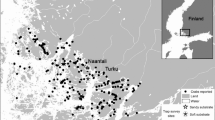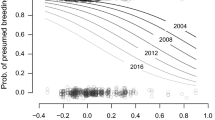Abstract
The Predation Danger Hypothesis suggests that shorebirds adjust aspects of their annual schedules to limit the amount of time they are exposed to the danger posed by the presence of Peregrine Falcons (Falco peregrinus) and other raptors. For example, Pacific Dunlin (Calidris alpina pacifica) remain near their breeding grounds on the Yukon-Kuskokwim Delta, Alaska to molt, and migrate southward after peak Peregrine Falcon migration has passed. This extended residence in the north may enable them to increase the time they devote to reproductive activities and enhancing their reproductive output, either by increasing the length of bi-parental brood care or by producing more clutches. In this paper, I describe the breeding ecology of Pacific Dunlin and relate my results to their migration strategy. Pacific Dunlin females deserted their broods, on average, at 5 days of age, leaving the remainder of the 19-day brood care period to their mates. This resembles the parental care patterns of other Calidris species. However, Pacific Dunlin exhibited a high propensity for replacing first clutches that failed (75%), and 17% of individuals who successfully hatched their first nest deserted their broods and went on to produce a clutch with a new mate (i.e., double brood). These rates are high compared to other subspecies of Dunlin suggesting that Pacific Dunlin take advantage of their extended time on the breeding grounds to increase their reproductive output.
Zusammenfassung
Die „Predation Danger”-Hypothese legt nahe, dass Küstenvögel bestimmte Aspekte ihres „Jahreskalenders” so ausrichten, dass sie die Zeit, die sie unter direkter Bedrohung durch Wanderfalken (Falco peregrinus) und andere Raubvögel stehen, möglichst klein halten. So bleiben zum Beispiel die Alpenstrandläufer (Calidris alpina pacifica) über die Mauser nahe ihrer Brutgebiete im Yukon-Kuskokwim-Delta, Alaska, und ziehen erst nach Süden, wenn der größte Pulk der ziehenden Wanderfalken durchgezogen ist. Dieses längere Verbleiben im Norden ermöglicht es ihnen vermutlich, mehr Zeit in die Reproduktionsaktivitäten zu stecken und damit ihren Bruterfolg zu vergrößern, entweder durch eine längere Brutpflege durch beide Elternteile, oder durch eine größere Anzahl Gelege. In dieser Arbeit beschreibe ich die Brut-Ökologie des Alpenstrandläufers und setze meine Ergebnisse in Beziehung zu ihrer Zug-Strategie. Die Weibchen des Alpenstrandläufers verlassen ihre Brut im Schnitt nach fünf Tagen und überlassen die restlichen 19 Tage Brutpflege ihren Partnern, was den Brutpflege-Gewohnheiten anderer Calidris-Arten ähnlich ist. Die Alpenstrandläufer jedoch zeigen eine starke Neigung, Erst-Gelege mit geringem Bruterfolg (75%) zu ersetzen; 17% der Individuen, die das Erst-Gelege erfolgreich ausgebrütet hatten, verließen ihre Brut und produzierten ein zweites Gelege mit einem neuen Partner (i.e., doppelte Brut). Diese Raten sind hoch im Vergleich mit anderen Strandläufer-Unterarten und lassen vermuten, dass Alpenstrandläufer ihre längere Verweildauer im Brutgebiet dazu nutzen, die Zahl ihrer Nachkommen zu vergrößern.





Similar content being viewed by others

References
Bêty J, Gauthier G, Giroux JF (2003) Body condition, migration, and the timing of reproduction in Snow Geese: A test of the condition-dependent model of optimal clutch size. Am Nat 162:110–121
Borowik OA, McLennan DA (1999) Phylogenetic patterns of parental care in Calidridine sandpipers. Auk 116:783–799
Burns JG, Ydenberg R (2002) The effects of wing loading and gender on the escape flights of least sandpipers (Calidris minutilla) and western sandpipers (Calidris mauri). Behav Ecol Sociobiol 52:128–136
Cramp S, Simmons KEL (1983) The birds of the Handbook of the birds of Europe, the Middle East and North Africa: the birds of the western Palearctic. Oxford University Press, Oxford
del Hoyo J, Elliot A, Sagatal J (1996) Handbook of the birds of the world, vol. 3: Hoatzins to Auks. Lynx, Barcelona
Gill RE, Handel CM (1990) The importance of subarctic intertidal habitats to shorebirds: A study of the central Yukon-Kuskokwim Delta, Alaska. Condor 92:709–725
Gratto-Trevor CL (1991) Parental care in the semipalmated sandpiper Calidris pusilla: brood desertion by females. Ibis 133:394–399
Heldt R (1966) Zur Brutbiologie des Alpenstrandläufers, Calidris alpina schinzii. Corax 1:173–188
Holmes RT (1966) Breeding ecology and annual cycle adaptations of the red-backed sandpiper (Calidris alpina) in northern Alaska. Condor 68:3–46
Holmes RT (1971) Latitudinal differences in the breeding and molt schedules of Alaskan red-backed sandpipers (Calidris alpina). Condor 73:93–99
Jamieson SE (2009) Cross-seasonal factors affecting breeding investment by female Pacific Dunlins. PhD dissertation, Simon Fraser University
Jönsson PE (1991) Reproduction and survival in a declining population of the southern dunlin Calidris alpina schinzii. Wader Study Group Bull 61:56–68
Kullberg C, Jakobsson S, Fransson T (2000) High migratory fuel loads impair predator evasion in sedge warblers. Auk 117:1034–1038
Lank DB, Butler RW, Ireland J, Ydenberg R (2003) Effects of predation danger on migration strategies of sandpipers. Oikos 103:303–319
Liebezeit JR, Smith PA, Lanctot RB, Schekkerman H, Tulp I, Kendall SJ, Tracy DM, Rodrigues RJ, Meltofte H, Robinson JA, Gratto-Trevor CL, McCaffery BJ, Morse JA, Zack SW (2007) Assessing the development of shorebird eggs using the flotation method: species-specific and generalized regression models. Condor 109:32–47
Love OP, Gilchrist HG, Descamp S, Semeniuk CAD, Bêty J (2010) Pre-laying climatic cues can time reproduction to optimally match offspring and ice conditions in an Arctic marine bird. Oecologia 164:277–286
Manolis JC, Andersen DE, Cuthbert FJ (2000) Uncertain nest fates in songbird studies and variation in Mayfield estimation. Auk 117:615–626
Mayfield HF (1975) Suggestions for calculating nest success. Wilson Bull 87:456–466
Meltofte H, Høye TT, Schmidt NM, Forchhammer MC (2007) Differences in food abundances cause inter-annual variation in the breeding phenology of High Arctic waders. Polar Biol 30:601–606
Miller EH (1985) Parental behavior in the least sandpiper (Calidris minutilla). Can J Zool 63:1593–1601
Naves LC, Lanctot RB, Taylor AR, Coutsoubos NP (2008) How often do Arctic shorebirds lay replacement clutches? Wader Study Group Bull 115:2–9
Ninni P, De Lope F, Saino N, Haussy C, Møller AP (2004) Antioxidants and condition-dependence of arrival date in a migratory passerine. Oikos 105:55–64
Page G (1974) Age, sex, molt and migration of dunlin at Bolinas Lagoon. West Birds 5:1–12
Poole A (2009) The Birds of North America Online. Cornell Laboratory of Ornithology. http://bna.birds.cornell.edu/bna/ Accessed 01 September 2009
Ruthrauff DR, Keller JN, Rizzolo DJ (2009) Ecological factors regulating brood attendance patterns of the western sandpipers Calidris mauri. Ibis 151:523–534
Schekkerman H, Tulp I, Calf KM, de Leeuw JJ (2004) Studies on breeding shorebirds at Medusa Bay, Taimyr, in summer 2002. Alterra report 922, Wageningen
Smith PA, Gilchrist HG, Forbes MR, Martin JL, Allard K (2010) Inter-annual variation in the breeding chronology of arctic shorebirds: Effects of weather, snow melt and predators. J Avian Biol 41:292–304
Soikkeli M (1967) Breeding cycle and population dynamics in the dunlin (Calidris alpina). Ann Zool Fenn 4:258–298
Soikkeli M (1970) Mortality and reproductive rates in a Finnish population of dunlin Calidris alpina. Ornis Fenn 47:149–158
Swaddle JP, Witter MS (1997) The effects of molt on the flight performance, body mass, and behaviour of European starlings (Sturnus vulgaris): an experimental approach. Can J Zool 75:1135–1146
Székely T, Lessells CM (1993) Mate change by Kentish povers Charadrius alexandrinus. Ornis Scand 24:317–322
Székely T, Williams TD (1994) Factors affecting timing of brood desertion by female Kentish plovers Charadrius alexandrinus. Behaviour 130:17–28
Székely T, Williams TD (1995) Costs and benefits of brood desertion in female Kentish plovers, Charadrius alexandrinus. Behav Ecol Sociobiol 37:155–166
Warnock ND, Gill RE (1996) Dunlin. In: Poole A, Gill F (eds) The Birds of North America, No. 203. Birds of North America, Inc., Ithaca
Wegge P, Vesterås T, Rolstad J (2010) Does timing of breeding and subsequent hatching in boreal forest grouse match the phenology of insect food for chicks? Ann Zool Fenn 47:251–260
Worcester R, Ydenberg R (2008) Cross-continental patterns in the timing of southward peregrine falcon migration in North America. J Raptor Res 42:13–19
Ydenberg R, Butler RW, Lank DB (2007) Effects of predator landscapes on the evolutionary ecology of routing, timing and molt by long-distance migrants. J Avian Biol 38:523–529
Acknowledgments
This research was supported by the Centre for Wildlife Ecology at Simon Fraser University, Environment Canada, Natural Sciences and Engineering Research Council (NSERC), US Fish and Wildlife Service, and the Northern Scientific Training Program. I would like to thank Catherine Dale, Émilie Germaine, Jean-Francoise Lamarre, Casper van Leeuwen, Sarah Lovibond, Olivier Meyer, and Erica van Rooij for their assistance in the field. Comments by Dov Lank, Heather Major, Kyle Morrison, Joe Nocera, Erica Nol, Tony Williams, and Ron Ydenberg greatly improved earlier drafts of this manuscript. This study complied with the current American and Canadian laws and permits were granted by Simon Fraser University, the State of Alaska, and the US Fish and Wildlife Service.
Author information
Authors and Affiliations
Corresponding author
Additional information
Communicated by P. H. Becker.
Rights and permissions
About this article
Cite this article
Jamieson, S.E. Pacific Dunlin Calidris alpina pacifica show a high propensity for second clutch production. J Ornithol 152, 1013–1021 (2011). https://doi.org/10.1007/s10336-011-0691-4
Received:
Revised:
Accepted:
Published:
Issue Date:
DOI: https://doi.org/10.1007/s10336-011-0691-4



